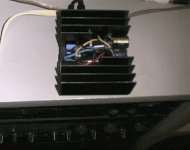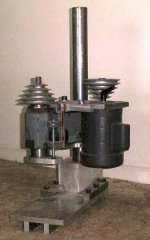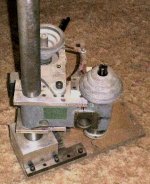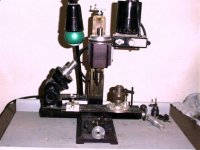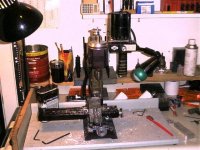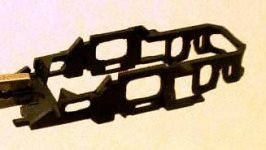I am shopping for a miter saw to do cuts on plate aluminum, but am trying figure out if I should get a slide 10" or a non-slide 12". I can't decide what's worse, the flex of a 12" blade, or the flex of the slide assembly. I feel like I need to get one of the two though, because you are still limited to a 8-10" cut max.
An 8" square tube extrusion seems awfully tall to put in a miter saw though...
I do have a belt sander, but it's only a 4x36. If I have to remove any significant material, I have a feeling that I'll have a tough time making the cut square.
Peter, table saw sounds like a good idea. Even having to do 4 passes, with a fence, it should all line up fine. I am a bit worried about doing an unclamped cut on metal though.
An 8" square tube extrusion seems awfully tall to put in a miter saw though...
I do have a belt sander, but it's only a 4x36. If I have to remove any significant material, I have a feeling that I'll have a tough time making the cut square.
Peter, table saw sounds like a good idea. Even having to do 4 passes, with a fence, it should all line up fine. I am a bit worried about doing an unclamped cut on metal though.
PD is right, I like my Makita 14" chop saw (flawless cuts, with a shine), but a table saw is as good a bet...
Doing it on a kitchen table?
Get some machinist's (marking) dye. Or do what I do, when I'm lazy...
Take a permanent marker pen and paint the area of the cut (do it twice, if you have to, to get a nice dark stain. Scribe (scratch a line) exactly along the needed cut. Use a square (meaning anything that is nearly a 90deg angle) to make the mark absolutely perfect all the way around.
Chop it off with an axe, if you have to... just be certain that, at no point along the line, you have actually touched your minimum dimension.
Grab a file. If the material is precious at the moment (backorders will do that to you), make your first mark a bit generous, and take it in 2 steps (practice doesn't make perfect, but it makes the nearly perfect look even better).
Best I know of, without putting electrons to work.
If you can get to a stationary belt sander, forget the file. But when you get close, remember to turn the piece over to make sure the rest (workpiece support) is square with the belt.
E
Doing it on a kitchen table?
Get some machinist's (marking) dye. Or do what I do, when I'm lazy...
Take a permanent marker pen and paint the area of the cut (do it twice, if you have to, to get a nice dark stain. Scribe (scratch a line) exactly along the needed cut. Use a square (meaning anything that is nearly a 90deg angle) to make the mark absolutely perfect all the way around.
Chop it off with an axe, if you have to... just be certain that, at no point along the line, you have actually touched your minimum dimension.
Grab a file. If the material is precious at the moment (backorders will do that to you), make your first mark a bit generous, and take it in 2 steps (practice doesn't make perfect, but it makes the nearly perfect look even better).
Best I know of, without putting electrons to work.
If you can get to a stationary belt sander, forget the file. But when you get close, remember to turn the piece over to make sure the rest (workpiece support) is square with the belt.
E
bzo said:I am shopping for a miter saw to do cuts on plate aluminum, but am trying figure out if I should get a slide 10" or a non-slide 12".
It is much easier (and cheaper) to get 10" non ferrous matal blades. I would go with 10" sliding.
If you buy a proper pro quality sliding mitre saw, such as Dewalt or Makita, as long as you don't force the cut, play is virtually non existant.bzo said:I can't decide what's worse, the flex of a 12" blade, or the flex of the slide assembly.
An 8" square tube extrusion seems awfully tall to put in a miter saw though... I am a bit worried about doing an unclamped cut on metal though.
Definately a job for the table saw. If you build yourself a sliding table, you can fix all the work holding clamps you want on it.
I have Ryobe saw from Home Depot. It's aluminum top and there is a sliding table as well, but I use it only for cutting angles.
I place a piece of 5/8 MDF on top, when cutting metal, as well as another piece of wood to protect fence. I slide the metal pieces and it almost feels like cutting wood, it just a bit slower. I'm not using any lubricant. I've been cutting 1" copper bars that way and 1/4" aluminum is no problem at all. To cross cut a bar, I'm using a square piece of MDF as a guide (6 x 6 with proper 90 deg angle) and it comes actually better than on miter saw. The edge (when passed second time) looks almost like after milling. Two passes on belt sander and it is perfect.
It took me a while to come to that method of metal cutting, as I also always thought that cutting aluminum on table saw is too dangerous. But it is not. The action of the blade is downward (to the table) so the material is very stable and there is no risk of it being pulled or pushed towards you (much less than with cutting wood as metal is much stiffer and won't block the blade).
I used to cut most of my work on band saw, now I mostly use table saw and it's like comparing tapping by hand to using cordless drill
Using safety glases is mandatory.
I place a piece of 5/8 MDF on top, when cutting metal, as well as another piece of wood to protect fence. I slide the metal pieces and it almost feels like cutting wood, it just a bit slower. I'm not using any lubricant. I've been cutting 1" copper bars that way and 1/4" aluminum is no problem at all. To cross cut a bar, I'm using a square piece of MDF as a guide (6 x 6 with proper 90 deg angle) and it comes actually better than on miter saw. The edge (when passed second time) looks almost like after milling. Two passes on belt sander and it is perfect.
It took me a while to come to that method of metal cutting, as I also always thought that cutting aluminum on table saw is too dangerous. But it is not. The action of the blade is downward (to the table) so the material is very stable and there is no risk of it being pulled or pushed towards you (much less than with cutting wood as metal is much stiffer and won't block the blade).
I used to cut most of my work on band saw, now I mostly use table saw and it's like comparing tapping by hand to using cordless drill
Using safety glases is mandatory.
"I used to cut most of my work on band saw, now I mostly use table saw and it's like comparing tapping by hand to using cordless drill."
Well then, I simply *have* to do it that way. After trying your tap tip, I have decided that you really *do* know it all...
Any tips on women??? Taxes?? Skydiving?

My Makita table saw has a weird "split" table. It is a real pita when cutting large sheet, but the very best for odd cuts. Looks perfect for our purposes, though. I'll be cutting up some 3 x 1 x .125 channel for the 6ch NIGC (if Online Metals ever gets it in), and have been looking at the thing with an eye toward making a clamp setup to replace the "rest".
Probably overkill, but if the first cut scares me, even a bit, I'll go for it.
E
Well then, I simply *have* to do it that way. After trying your tap tip, I have decided that you really *do* know it all...
Any tips on women??? Taxes?? Skydiving?
My Makita table saw has a weird "split" table. It is a real pita when cutting large sheet, but the very best for odd cuts. Looks perfect for our purposes, though. I'll be cutting up some 3 x 1 x .125 channel for the 6ch NIGC (if Online Metals ever gets it in), and have been looking at the thing with an eye toward making a clamp setup to replace the "rest".
Probably overkill, but if the first cut scares me, even a bit, I'll go for it.
E
something a bit more appropriate...
This is my Sherline mill. It is a very highly regarded piece with only one flaw. Workpiece size. The heat sink (above), that is now my first GC, barely fit.
Hence the need for the custom one.
Point of pic? Look at the fixtures I have built. They would serve well even on a drill press, and would cost you very little to duplicate.
On the left is the head from a camera tripod. The versatility of this piece has to be seen to be believed.
The chuck on the right is simply an old Jacobs (look for 'em, good stuff) from an old heavy (and very dead) hand drill.
Make yourself the chuck fixture... you won't regret it.
E
This is my Sherline mill. It is a very highly regarded piece with only one flaw. Workpiece size. The heat sink (above), that is now my first GC, barely fit.
Hence the need for the custom one.
Point of pic? Look at the fixtures I have built. They would serve well even on a drill press, and would cost you very little to duplicate.
On the left is the head from a camera tripod. The versatility of this piece has to be seen to be believed.
The chuck on the right is simply an old Jacobs (look for 'em, good stuff) from an old heavy (and very dead) hand drill.
Make yourself the chuck fixture... you won't regret it.
E
Attachments
In case someone is thinking these are Parlor Queens... 
There is a lot of homemade stuff in this pic, but expensive tapping/cutting lube...
It's Tapmatic. I swear by it. Magura gave us good lessons in lubes, right here, but if you can spend a few bucks on a lifetime supply, try this. His situation is so far from DIY that he (his company?) can save significant money this way.
Try it, and make up your own mind what works for you... Buy a can and three or four small dispensors. Give it to all your DIY friends.
So, Unhinged, how goes it? Having fun yet?
E
There is a lot of homemade stuff in this pic, but expensive tapping/cutting lube...
It's Tapmatic. I swear by it. Magura gave us good lessons in lubes, right here, but if you can spend a few bucks on a lifetime supply, try this. His situation is so far from DIY that he (his company?) can save significant money this way.
Try it, and make up your own mind what works for you... Buy a can and three or four small dispensors. Give it to all your DIY friends.
So, Unhinged, how goes it? Having fun yet?
E
Attachments
Hey ekd, how big of a mill are you building?
I actually was considering a Sherline to do a CNC retrofit, but the table was too small for what I was looking for. I am thinking about using an actual Sherline head for my CNC project though. It doesn't seem like there are a lot of options for a real milling head (i.e. not something like a dremel or router) on a table as small as I'm builiding (12" x 18").
I actually was considering a Sherline to do a CNC retrofit, but the table was too small for what I was looking for. I am thinking about using an actual Sherline head for my CNC project though. It doesn't seem like there are a lot of options for a real milling head (i.e. not something like a dremel or router) on a table as small as I'm builiding (12" x 18").
Sherline tables/throats are too small for *everything*, and require a lot of re-positioning.
We are in the same boat. I wouldn't have attempted the mill if there was anything accurate (realisticly priced) out there.
The one quality example (I forget the name) of what we need is so overpriced as to allow you to buy a good used Lagun (9 x 49), if you have room for it.
Sherline will sell you a good head unit, but don't abuse it. They are supremely accurate if you treat them well.
Pic is of HO scale (size of Matchbox cars) slotcar frame lightened as much as possible, in the Sherline.
E
We are in the same boat. I wouldn't have attempted the mill if there was anything accurate (realisticly priced) out there.
The one quality example (I forget the name) of what we need is so overpriced as to allow you to buy a good used Lagun (9 x 49), if you have room for it.
Sherline will sell you a good head unit, but don't abuse it. They are supremely accurate if you treat them well.
Pic is of HO scale (size of Matchbox cars) slotcar frame lightened as much as possible, in the Sherline.
E
Attachments
Drilling and tapping tips that I have found very useful...
1. The more flutes, the weaker the tap. Plain & simple.
2. Hand taps (~those taps having four flutes) are easiest to start straight into the hole.
3. Hand taps are, however, a PIA to use because the chip space (the "gullet") is so small. (All machining is controlled by the space where the chip is formed. The "chip face" is one of the controlling factors of machining. Once the gullet is filled, the process is no longer controllable. This would apply to taps, to saws, even to sandpaper.)
4. Practice using 2-flute machine taps (often 3-flute in larger sizes) and starting straight. The larger chip space makes quicker tapping and less backing out and "chip breaking". Always clean the chips off the tap befopre starting the next hole. (Duh?)
5. The perfect apping fluid for aluminum is kerosene with a little bit of lard (4%). The scented varieties will add a pleasant smell to the den. BONUS! Lard also makes the best pie crust. Gasoline is not a reasonable substitute for kerosene in tapping or pie crusts!
6. A suitable alternative to tapping fluid would be WD-40 for aluminum. My absolute preference for steel is Trim-Tap (Master Chemical). LPS Tapmatic Edge is a very reasonable product and comes in a toothpaste tube. Motor oil is useless for tapping. Saliva is better than motor oil.
7. Brass & copper alloys tend to "grab" drills. Break the edge of the drill lip to slightly dull the cutting edge. Much prefereable and will stop the "grab".
8. Mentioned before... try not to use your "aluminum" stuff on steel. The aluminum machines best with dead sharp cutting tools.
9. Lexan, Plexi, and other polycarbonates can often be drilled at high speed with "reverse rotation" of the drill. Effectively, the plastic melts and is not cut. This is very suitable for small holes. A hot nail also works very well.
10. The absolute best coolant for cutting these clear plastics are household cleaners like Fantastik or Formula 409 (is it the lye?). It is possible to mill these and obtain very, very clear finishes. Just a note to wash off your tooling in water and apply anti-corrosion coating when you are finished.
11. Some more tapping stuff. Find a local industrial supply store in your area. Some are better than others, especially for the average Joe that comes on off the street looking for quantity one of a 6-32 four flute gun tap! Their "economy import" stuff is most often superior to the best in the hardware strore. Eastern block stuff is very good quality and reasonably priced. Emuge, OSG, etc. are first class ~ if you are doing production work on machining centers ~ otherwise save your money for four thousand dollar speaker cables. Further, the current Euro pricing really adds to the "premium" image!
Decent domestic selections... Netco Chromeclad, Besly, Regal.
12. Some more drilling stuff. For most guys, avoid the "gold" colored tools. They suck in aluminum. The "gold", titanium nitride (also refered to as T-I-N or "tin") is sticky in aluminum and results in galling. TIN is nice for most other materials.
Best drills? It is impossible to drill with positional accuracy using a standard 118 degree twist drill. If it was possible, then God would not have invented the center drill. A couple of small (size 0 or size 1) center drills are pretty handy when you don't want the drill to "walk". Operate center drills at 1/3 of the speed of the "normal".
A better solution is the "split point" drill. This is where additional cutting edges are ground into the "chisel edge". That's the part of the drill that isn't typically helping out, right at the very point. Split point drills will generally not walk. The thing to order at the supply store is a "screw machine length split point drill". They are shorter than "jobber" length and are just perfect for most work. Even 1/4"-20 has a 1" drilling length... more if you peck.
13. I have point 13 to talk about braking taps. Try tapping with a cordless drill, it's not hard. Just do it on something that doesn't matter until you get good at it! Don't try power tapping with hand taps (four flutes). I will typically power tap #10 and larger. If it's an expensive piece or the "last op", the I'll hand tap. I always chamfer the hole edge with a countersinking tool. It easiter to start the tap and shows some signs of proficiency! M. A. Ford makes the best ones. For small taps, I also prefer a racheting handle. You don't have to rachet, but when you need a little extra room, you REALLY need it.
This started as two cents... it finished as six bits!
1. The more flutes, the weaker the tap. Plain & simple.
2. Hand taps (~those taps having four flutes) are easiest to start straight into the hole.
3. Hand taps are, however, a PIA to use because the chip space (the "gullet") is so small. (All machining is controlled by the space where the chip is formed. The "chip face" is one of the controlling factors of machining. Once the gullet is filled, the process is no longer controllable. This would apply to taps, to saws, even to sandpaper.)
4. Practice using 2-flute machine taps (often 3-flute in larger sizes) and starting straight. The larger chip space makes quicker tapping and less backing out and "chip breaking". Always clean the chips off the tap befopre starting the next hole. (Duh?)
5. The perfect apping fluid for aluminum is kerosene with a little bit of lard (4%). The scented varieties will add a pleasant smell to the den. BONUS! Lard also makes the best pie crust. Gasoline is not a reasonable substitute for kerosene in tapping or pie crusts!
6. A suitable alternative to tapping fluid would be WD-40 for aluminum. My absolute preference for steel is Trim-Tap (Master Chemical). LPS Tapmatic Edge is a very reasonable product and comes in a toothpaste tube. Motor oil is useless for tapping. Saliva is better than motor oil.
7. Brass & copper alloys tend to "grab" drills. Break the edge of the drill lip to slightly dull the cutting edge. Much prefereable and will stop the "grab".
8. Mentioned before... try not to use your "aluminum" stuff on steel. The aluminum machines best with dead sharp cutting tools.
9. Lexan, Plexi, and other polycarbonates can often be drilled at high speed with "reverse rotation" of the drill. Effectively, the plastic melts and is not cut. This is very suitable for small holes. A hot nail also works very well.
10. The absolute best coolant for cutting these clear plastics are household cleaners like Fantastik or Formula 409 (is it the lye?). It is possible to mill these and obtain very, very clear finishes. Just a note to wash off your tooling in water and apply anti-corrosion coating when you are finished.
11. Some more tapping stuff. Find a local industrial supply store in your area. Some are better than others, especially for the average Joe that comes on off the street looking for quantity one of a 6-32 four flute gun tap! Their "economy import" stuff is most often superior to the best in the hardware strore. Eastern block stuff is very good quality and reasonably priced. Emuge, OSG, etc. are first class ~ if you are doing production work on machining centers ~ otherwise save your money for four thousand dollar speaker cables. Further, the current Euro pricing really adds to the "premium" image!
Decent domestic selections... Netco Chromeclad, Besly, Regal.
12. Some more drilling stuff. For most guys, avoid the "gold" colored tools. They suck in aluminum. The "gold", titanium nitride (also refered to as T-I-N or "tin") is sticky in aluminum and results in galling. TIN is nice for most other materials.
Best drills? It is impossible to drill with positional accuracy using a standard 118 degree twist drill. If it was possible, then God would not have invented the center drill. A couple of small (size 0 or size 1) center drills are pretty handy when you don't want the drill to "walk". Operate center drills at 1/3 of the speed of the "normal".
A better solution is the "split point" drill. This is where additional cutting edges are ground into the "chisel edge". That's the part of the drill that isn't typically helping out, right at the very point. Split point drills will generally not walk. The thing to order at the supply store is a "screw machine length split point drill". They are shorter than "jobber" length and are just perfect for most work. Even 1/4"-20 has a 1" drilling length... more if you peck.
13. I have point 13 to talk about braking taps. Try tapping with a cordless drill, it's not hard. Just do it on something that doesn't matter until you get good at it! Don't try power tapping with hand taps (four flutes). I will typically power tap #10 and larger. If it's an expensive piece or the "last op", the I'll hand tap. I always chamfer the hole edge with a countersinking tool. It easiter to start the tap and shows some signs of proficiency! M. A. Ford makes the best ones. For small taps, I also prefer a racheting handle. You don't have to rachet, but when you need a little extra room, you REALLY need it.
This started as two cents... it finished as six bits!
I agree with most of what chipco3434 wrote.
Many of the choices he makes would not be my first choice though, but for DIY I guess my standards are overkill. Im spoiled when it comes to tools and machinery, on that background its hard to accept less for a DIY project. It would haunt me if i knew the box was made to a lower standard than the best i could possibly achieve. As Peter Daniel wrote earlier...this is DIY not aerospace tech. and should be dealt with as such.
Having said that, there is a reason why fette and OSG and so forth are expensive. They actually are very cost effective, so the price per meter of thread for a chinese tap and for a Fette tap is compareably a bad deal for the chinese tap. A Fette will last longer per (insert your favourite monetary unit).
That most DIY'ers break the taps before that becoes an issue is a different story.
Magura
Many of the choices he makes would not be my first choice though, but for DIY I guess my standards are overkill. Im spoiled when it comes to tools and machinery, on that background its hard to accept less for a DIY project. It would haunt me if i knew the box was made to a lower standard than the best i could possibly achieve. As Peter Daniel wrote earlier...this is DIY not aerospace tech. and should be dealt with as such.
Having said that, there is a reason why fette and OSG and so forth are expensive. They actually are very cost effective, so the price per meter of thread for a chinese tap and for a Fette tap is compareably a bad deal for the chinese tap. A Fette will last longer per (insert your favourite monetary unit).
That most DIY'ers break the taps before that becoes an issue is a different story.
Magura
Hello everyone, Im back from the land of washing dishes for another few days 
On the line of CNC heads and stuff, have any of you heard of Peatol lathes (theyre called Taig i think in the US)
Peatol lathes
Taig lathes
Im sure the headstock would do nicely for a small DIY cnc mill, they use it on their own mill, though Ive never tried one or seen one in the flesh. Bits and pieces from this crop up on ebay occasionally too.
Steve
On the line of CNC heads and stuff, have any of you heard of Peatol lathes (theyre called Taig i think in the US)
Peatol lathes
Taig lathes
Im sure the headstock would do nicely for a small DIY cnc mill, they use it on their own mill, though Ive never tried one or seen one in the flesh. Bits and pieces from this crop up on ebay occasionally too.
Steve
That's IT!!!
I'm sick of guys who drop in and give advice about things they have no experience in...
Perfect example:
"Gasoline is not a reasonable substitute for kerosene in tapping or pie crusts!'
Oh, yeah? You've never had *my* pie!

We have the skills, we have the tools, and we have the brains...
What we need here is a victim...er, project. Is Unhinged still around?
E
I'm sick of guys who drop in and give advice about things they have no experience in...
Perfect example:
"Gasoline is not a reasonable substitute for kerosene in tapping or pie crusts!'
Oh, yeah? You've never had *my* pie!
We have the skills, we have the tools, and we have the brains...
What we need here is a victim...er, project. Is Unhinged still around?
E
Another tip on how to start a properly aligned tap (it is quite important sometimes, as I noticed that some of my 1" cones were not actually sitting flat against metal surface).
I set my drill press to slow speed, turn it on and switch it off right away. It has enough momentum to rotate the tap at least 3 times before it stops and after doing it 2-3 times, you have a start of perfectly straight thread. I finish the rest by using cordless drill.
Racheting handle for manual tapping is indeed much better than conventional one, as it's much easier to hold the tap straight. You can get one from Sears.
I set my drill press to slow speed, turn it on and switch it off right away. It has enough momentum to rotate the tap at least 3 times before it stops and after doing it 2-3 times, you have a start of perfectly straight thread. I finish the rest by using cordless drill.
Racheting handle for manual tapping is indeed much better than conventional one, as it's much easier to hold the tap straight. You can get one from Sears.
- Status
- This old topic is closed. If you want to reopen this topic, contact a moderator using the "Report Post" button.
- Home
- General Interest
- Everything Else
- Cutting, drilling, mounting etc. for the absolute beginner
